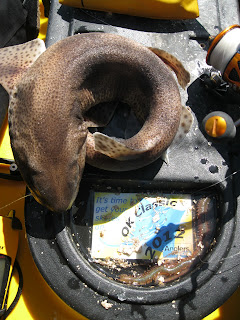I took a few photos as I got closer to the ship, I asked one of the crew who was handing out military leaflets on the shore, ''How close am I allowed to go?'', ''50yards'' was my answer...
Got rather close and was admiring the vessel when I look up and see a chap with a machine gun looking right down his scope at me. He followed me while I circled the front of the boat and then I thought I'm off fishing before I get shot! The ship itself was huge when I paddled up to it, the picture from the front shows how far it sticks out of the water, it looks like it should just topple over!
Quick toilet stop with the ship in the background, I covered a fair few miles in the end. The ship is a couple of miles in the background. A quick relaunch saw me paddle for the fishing grounds I wanted to try.
Anyway the fishing was ok, for species hunting anyway. I got some good experience anchoring and snagging twice but managed to break free both times... Eventually! I had to let alot of my anchor line out and paddle at full speed to break free but it worked both times. In the end I had a few Pout, a first Poor Cod from the kayak, Dogfish galore, Ballan and Corkwing Wrasse, Mackerel, a Garfish and a Black Goby which was a new fish for me. So with 8 species and 1 new one I was fairly happy. Below is the picture of the Corkwing Wrasse and Poor Cod.
Then a picture of the Back Goby, at first I thought it was a Rock Goby but after checking with someone it was confirmed as a Black Goby. This was due to the fact it had an elongated dorsal fin and the Rock Goby does not have this.
Now the best moment and catch of the lot... I hook something that is a very heavy weight and it seems like I am stuck on the bottom. However, a fish is definitely hooked, so I keep a bit of pressure on it hoping it will pull free when I realise it is slowly coming up. Whatever it is, it's really heavy!!! I'm thinking a big Ray had sucked bottom at this point, then after 5 minutes of heaving and anticipation I see a Garfish on the top hook. I think surely there is a Ray on the bottom hook.
NOPE, IT'S THIS ON THE BOTTOM...
A ROCK FISH!
On the way back in I saw another kayaker fishing at anchor. He was pulling up lots of mackerel and I had a good chat with him. We spoke about Bass fishing so I offered to take him to a few marks in the summer and guarenteed him at least one or two, lets hope that hasn't jynxed me! It's also clear this sport is really taking off and it's great to be a part of it.



















































